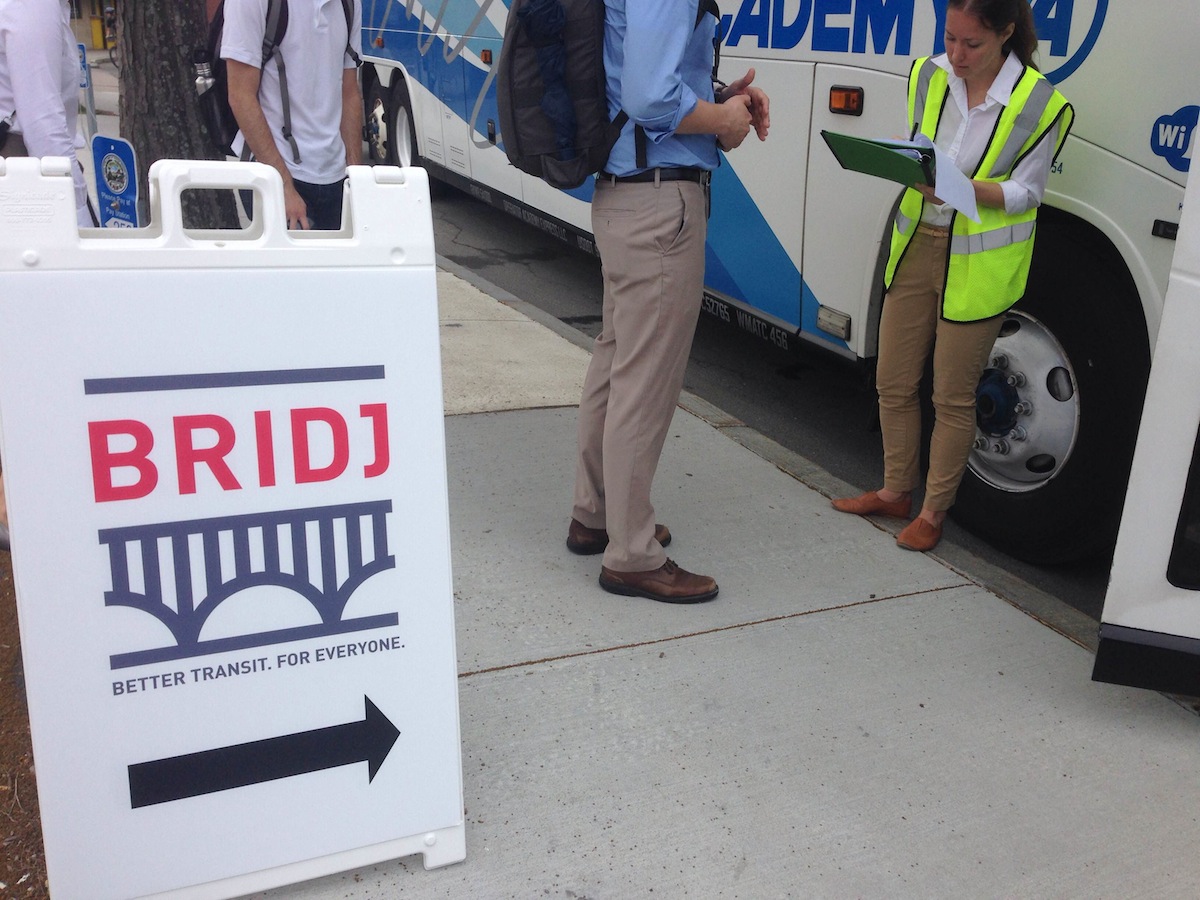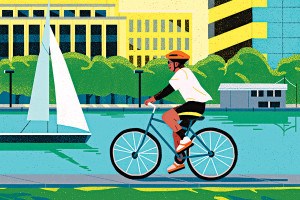What’s Faster: a Bridj Bus or the MBTA?

Photo by Steve Annear
When Bridj, a pop-up luxury bus service with direct routes to Cambridge and Boston, launched last month, the company came out swinging with claims that the startup’s transportation methods rival the commute time of MBTA riders on similar routes.
While some people questioned those fightin’ words and others decried their methods on Twitter, we decided the best way to put the argument to rest would be to race both transit options during the morning rush hour.
To determine if Bridj’s testimony was legit, we boarded one of their buses in Brookline’s Coolidge Corner on Tuesday morning and headed toward Kendall Square, at the same time a second Boston employee hopped on the MBTA’s Green Line stop nearby en route to the same destination.
The winner? Our Bridj ride from Brookline to Kendall Square, which took 10 minutes less than the T rider’s trip along the Green Line to Park Street, then on the Red Line to get to Cambridge. Plus, the Bridj ride was not only quicker—it was a bit more relaxed, too.
To test the accuracy of the trips, both the Bridj rider and the T commuter timed their Tuesday morning commute and kept tabs on their experiences as they traveled toward Kendall Square. The MBTA passenger arrived last, even though she had a head start and boarded the train six minutes prior to Bridj’s departure. Below is a snapshot of the recorded travel times, side-by-side:

While some people might feel like 10 minutes shaved off of a morning commute isn’t much, it was the amenities and comfort that seemed to truly set the two commutes apart. For the MBTA traveler, the morning commute was filled with riders cramming onto train cars, loudly chewing gum just inches away, and dealing with negative, intrusive banter from complete strangers. The timing of the T commuter’s arrival was also based on the fact there were no delays in service, and that there was a Red Line train awaiting passengers right as they transferred from the Green Line at Park Street. The commute could have been an extra five minutes or so if she had to wait for the next Red Line train to get there, she said.
As the MBTA rider maneuvered the underground, the passenger who relied on Bridj had a different experience. For starters, he was met by cushioned chairs, air-conditioning, and a working bathroom located at the back of the bus. Traffic was relatively heavy given the time of morning, but even with construction on the roads, the entire route only took 21 minutes door-to-door. Of course, Bridj, too, had its downfalls. The bus was arguably noisier than the train, the service doesn’t currently have return trips, and the cost will soon be double that of a one-way T ride.
As we sat on the Bridj bus, we chatted with the company’s CEO, Matthew George, and talked about some of the roadblocks the data-driven startup has faced since launching their beta service in May, and what new features and travel lines customers can expect moving forward. Here’s what he had to say:
Is Bridj really faster than the T?
There have been plenty of folks that have posted about it. We have a lot of people who are traveling anywhere from 35 to 55 minutes [on the T]. But as you know it’s a crapshoot.
What are the benefits of taking Bridj instead of the T every morning?
It’s time. You’ll see it in terms of overall time savings. Our downtown route, the time savings aren’t that great—it’s maybe five minutes. We are averaging about five minutes in time-savings. But if you’re looking at someone that’s taking the Green Line all the way down, or doing some other combination of travel, being able to sit and do work in a chair, rather than standing up, crammed in the train—we think it’s definitely a different experience.
Right now you’re in Beta mode, when will you come out of that?
We are going to start charging sometime in July. And then we will be in Beta technically forever. We’re introducing new routes, too. This week we tripled the level of service.
What happens from here?
Next step for us is adding an additional route from Coolidge Corner down to Copley Square, starting next week. And then, I think there’s some discussion of having the route going all the way down to the Seaport. That way we really have Coolidge Corner covered in terms of at least the big destinations. [A packed Green Line train pulls up next to the Bridj bus.] Look at the Green Line. It’s just sardines.
It looks packed. But what about price points? What’s your model going to look like?
Depending on how far you’re going in the city, the average price is going to be anywhere from $5 to $6 per trip. A single trip. So you are looking at $2.50 on the T, as opposed to us, which is $5. It is significantly more, however, we think providing more options to people at a wider price range allows people to choose whether they value their time, and how much they value their commute. We will certainly see folks who are riding during the free beta phase not take it, but we completely understand that. We are going to introduce some smaller vehicles—33 to 35 passenger buses—which will have features like leather seats and things like that. The biggest point of doing this is to prove we can take the biggest buses and put them on routes that we think we’re able to. Going down to smaller buses, we think there will be a demand, and it’s another price option.
So you think you’ll offer monthly options?
Absolutely. We haven’t announced or confirmed pricing on that yet, but we are going to offer sort of a discounted monthly, and that really ties into folks who have commuter passes and programs through their employers.
What about return trips? You guys don’t have them yet.
What’s the date today? June 10. My birthday, mind you [laughs]. I think what the plan was is to do that a little bit later in the month, so at least by the start of July we will at least start to trial some of the returns. We will probably do the returns first from Kendall, because we have a relationship with the city of Cambridge, and there’s lots of demand, and we have a really good pick-up spot where we can sort of load the bus. Pick-up spots are always sort of a restraining factor, because it’s busy at 5:30.
But they will be coming soon.
Yeah, absolutely. We move at lightning speed here. If we don’t, somebody else will.
Will there be more routes added?
Of course. We sort of just picked Coolidge Corner and said, ‘let’s prove our operation, let’s prove our ability to retain a bunch of users,’ and then rapidly start to go residential neighborhood by residential neighborhood—places like Somerville, places like Southie. There will be a lot of different drop-off destinations as well. Despite people’s best claims, when we look at how we introduce service, we take anywhere from 15 to 19 different data streams, analyze that neighborhood—we are not looking at signs ups and saying ‘where do people want to go?,’ we are looking at everything from census data to social media data. When we go into a new market we really understand where people are traveling to. We have solid orders of magnitude. Then we introduce routes based on that. We are going to be able to do that pretty quickly, and in July the goal is to introduce a new origin point about every week. And there’s about 40 routes we are planning on introducing.
How about an app?
We will have a consumer-facing app that will allow you to check in, especially when we go paid. When we do go paid, you will have Bridj pass options that you can purchase, you can enter your employer for a subsidy, and you hit ‘purchase pass’ and see exactly where the route is, where the bus is on the route, and click on any one of the stops to see some information about it. When you purchase a pass an image will come up that you can easily show to the driver and say, ‘hey, I have a validated pass.’ On of our big commitments…was really making sure we have very fast times, especially when picking up and dropping off. By developing that app, really getting people on and off quickly, and provide information they need—it’s a win for us and a win for municipalities. But most of all, it’s a win for the customer.
A lot is going to be happening for you guys in the coming months.
A lot is happening now. We have so much going on, and we’re introducing so many new routes. If you look around, we are helping a lot of people sort of move around the city faster.
This interview was condensed for clarity.


